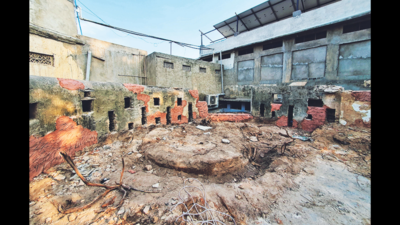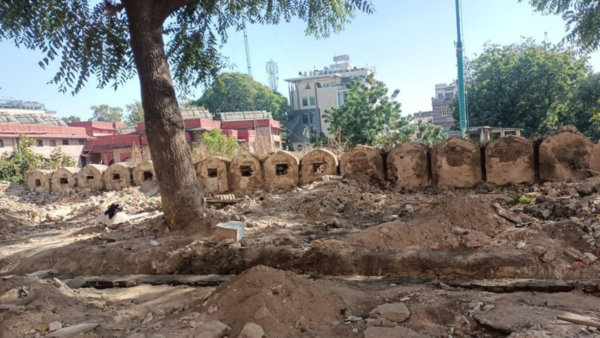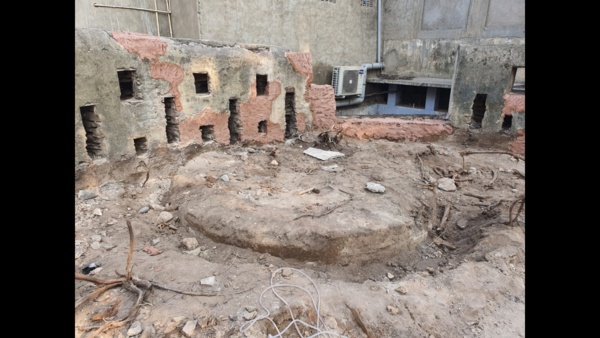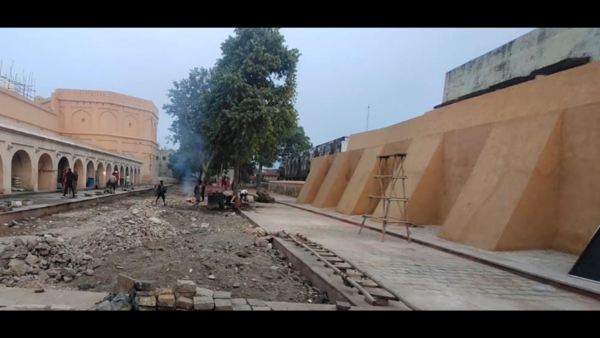- News
- City News
- jaipur News
- 3 bastions among many structures discovered at Akbar Fort in Ajmer
Trending
This story is from January 16, 2022
3 bastions among many structures discovered at Akbar Fort in Ajmer
The department of archaeology and museums has discovered several unknown structures at the 16th Century Ajmer Mughal Fort, including three bastions, an 18-feet security wall, and a pedestal for cannon firing.

The bastions were made to strengthen the fort walls and to provide additional space for armouries like passage for hot oil and later guns
JAIPUR: The department of archaeology and museums has discovered several unknown structures at the 16th Century Ajmer Mughal Fort, including three bastions, an 18-feet security wall, and a pedestal for cannon firing.
The scientific clearance to remove the structures from the encroached land was recently acquired by the fort from the state animal husbandry department.

The discovery has strengthened the historians’ claims that the fort which was constructed in 1570 CE was the most modern one and was equipped with the latest security features.

"The bastions were made to strengthen the fort walls and to provide additional space for armouries like passage for hot oil and later guns. The diameter of these bastions ranges between 16 feet to 30 feet which made it impossible for any invasion.
The discovery will help us in re-designing the changing shapes of the fort during the Mughal period," said department of archaeology and museums, Ajmer division circle superintendent, Neeraj Tripathi.

The second discovery is that of the pedestal for firing canon. "The fort was also a revenue collection point for Mughals of the entire region. Records say that at one point in time, 29% of the total revenue was kept at the Daulat Khana in Ajmer fort. Mughals had left no means to make the fort mark of their strength. The cannon pedestal was a showcase of their strength," said Tripathi.
After Mughals, the fort slipped into the hands of the Marathas and subsequently Britishers. The fort was subjected to widespread encroachments until the formation of Rajasthan. "The clearance work becomes possible only after the government veterinary hospital was vacated last year. I am expecting that once the entire encroachment is removed, many missing links can be traced to bring back the lost glory of the fort," said Tripathi.
The scientific clearance to remove the structures from the encroached land was recently acquired by the fort from the state animal husbandry department.

The discovery has strengthened the historians’ claims that the fort which was constructed in 1570 CE was the most modern one and was equipped with the latest security features.
Mughal Emperor Akbar (1556-1605 CE) was regular to Ajmer from 1570 CE to 1582 CE with a record of visiting Ajmer every year during the period. Emperor Jahangir (1569 CE-1627 CE) stayed for three years from 1613 CE to 1616 CE eyeing on his vast kingdom.

"The bastions were made to strengthen the fort walls and to provide additional space for armouries like passage for hot oil and later guns. The diameter of these bastions ranges between 16 feet to 30 feet which made it impossible for any invasion.
The discovery will help us in re-designing the changing shapes of the fort during the Mughal period," said department of archaeology and museums, Ajmer division circle superintendent, Neeraj Tripathi.

The second discovery is that of the pedestal for firing canon. "The fort was also a revenue collection point for Mughals of the entire region. Records say that at one point in time, 29% of the total revenue was kept at the Daulat Khana in Ajmer fort. Mughals had left no means to make the fort mark of their strength. The cannon pedestal was a showcase of their strength," said Tripathi.
After Mughals, the fort slipped into the hands of the Marathas and subsequently Britishers. The fort was subjected to widespread encroachments until the formation of Rajasthan. "The clearance work becomes possible only after the government veterinary hospital was vacated last year. I am expecting that once the entire encroachment is removed, many missing links can be traced to bring back the lost glory of the fort," said Tripathi.
End of Article
FOLLOW US ON SOCIAL MEDIA










